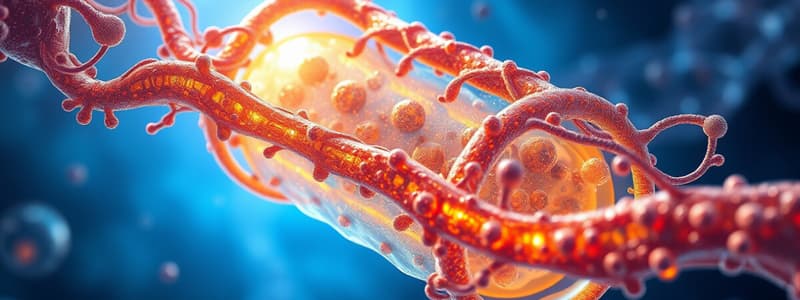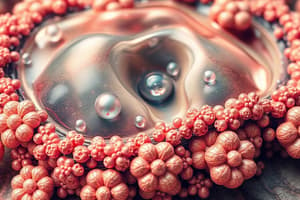Podcast
Questions and Answers
Which function is NOT associated with lipid rafts?
Which function is NOT associated with lipid rafts?
- Signal transduction
- Cell division (correct)
- Protein trafficking
- Membrane fluidity
What characterizes integral proteins in the membrane?
What characterizes integral proteins in the membrane?
- They are partially or totally immersed in the lipid bilayer. (correct)
- They are immobile and cannot move within the membrane.
- They only interact with the hydrophilic heads of phospholipids.
- They are temporarily attached to the membrane surface.
Which of the following statements about membrane carbohydrates is accurate?
Which of the following statements about membrane carbohydrates is accurate?
- They compose a majority of the membrane composition.
- They are solely responsible for the membrane's fluid nature.
- Carbohydrates can exist freely in the membrane.
- They always attach as glycoproteins or glycolipids. (correct)
What does the fluid mosaic model emphasize about the structure of plasma membranes?
What does the fluid mosaic model emphasize about the structure of plasma membranes?
What ensures the membrane remains fluid at normal cellular temperatures?
What ensures the membrane remains fluid at normal cellular temperatures?
What is the movement of phospholipids within a bilayer called?
What is the movement of phospholipids within a bilayer called?
What is one of the primary functions of biological membranes?
What is one of the primary functions of biological membranes?
How often does a phospholipid molecule typically undergo flip-flop movement?
How often does a phospholipid molecule typically undergo flip-flop movement?
What effect does cholesterol have on phospholipid bilayers?
What effect does cholesterol have on phospholipid bilayers?
Which component of the cell membrane is primarily responsible for its selectively permeable nature?
Which component of the cell membrane is primarily responsible for its selectively permeable nature?
What is the primary function of glycolipids in cell membranes?
What is the primary function of glycolipids in cell membranes?
How does the protein-to-lipid ratio in cell membranes vary?
How does the protein-to-lipid ratio in cell membranes vary?
Which protein marker is specific to the plasma membrane?
Which protein marker is specific to the plasma membrane?
What defines lipid rafts in cell membranes?
What defines lipid rafts in cell membranes?
What is the nature of phospholipids in biological membranes?
What is the nature of phospholipids in biological membranes?
What role does the OH group of cholesterol play in the phospholipid bilayer?
What role does the OH group of cholesterol play in the phospholipid bilayer?
Which of the following statements about carbohydrates in cell membranes is true?
Which of the following statements about carbohydrates in cell membranes is true?
What percentage of cell membrane content is typically cholesterol?
What percentage of cell membrane content is typically cholesterol?
Which of the following describes the hydrophobic and hydrophilic regions of a phospholipid?
Which of the following describes the hydrophobic and hydrophilic regions of a phospholipid?
Which statement about protein mobility in membranes is correct?
Which statement about protein mobility in membranes is correct?
Which of the following components contributes to the diverse functions of cell membranes?
Which of the following components contributes to the diverse functions of cell membranes?
What effect does an increase in temperature have on membrane fluidity?
What effect does an increase in temperature have on membrane fluidity?
How does the chain length of fatty acids impact the fluidity of a membrane?
How does the chain length of fatty acids impact the fluidity of a membrane?
What is the role of double bonds in fatty acids concerning membrane fluidity?
What is the role of double bonds in fatty acids concerning membrane fluidity?
How does cholesterol influence membrane fluidity at high temperatures?
How does cholesterol influence membrane fluidity at high temperatures?
Which type of fatty acids increases membrane fluidity due to their configuration?
Which type of fatty acids increases membrane fluidity due to their configuration?
Which of the following is NOT a class of membrane proteins?
Which of the following is NOT a class of membrane proteins?
What is the effect of low temperature on membrane fluidity?
What is the effect of low temperature on membrane fluidity?
What is one function of membrane proteins classified as receptors?
What is one function of membrane proteins classified as receptors?
Flashcards are hidden until you start studying
Study Notes
Functions of Biological Membranes
- Selectively permeable, allowing specific substances to cross.
- Creates a concentration gradient between extracellular fluid (ECF) and intracellular fluid (ICF).
- Facilitates cell-to-cell communication.
- Identifiable by specific protein markers, e.g., Na,K-ATPase for plasma membranes and succinate dehydrogenase for mitochondria.
- Serves as a site for various chemical reactions.
Major Components of Cell Membranes
- Comprised of lipids, proteins, and carbohydrates linked either to lipids or proteins; carbohydrates are never free.
- Different membranes exhibit varying protein-to-lipid ratios, affecting the composition.
Phospholipids
- Types include phosphatidylcholine, ethanolamine, phosphatidylserine, cardiolipin, and sphingomyelin.
- Amphipathic nature: hydrophilic head and hydrophobic fatty acid tails.
- Phospholipids exhibit lateral movement within the bilayer, allowing dynamic changes in cell shape (2 mm/sec).
- Transverse diffusion (flip-flop) occurs infrequently (every several hours).
- Proteins mostly do not rotate within the membrane.
Lipid Bilayers
- Composed of phospholipids arranged in a bilayer.
- Asymmetric structure where lipid composition differs between leaflets.
Cholesterol
- Comprising 5-25% of membrane content, it is a key structural component.
- Cholesterol molecules exist between phospholipids, affecting membrane fluidity by reducing lateral movement.
- Its arrangement (OH group near polar heads) contributes to overall membrane stability.
Glycolipids
- Combinations of carbohydrates and lipids; less abundant (<5%).
- Carbohydrates are attached to phospholipids and oriented outward, facilitating cellular recognition and tissue formation.
Lipid Rafts
- Thicker membrane microdomains enriched with cholesterol and sphingolipids.
- Facilitate signal transduction, protein trafficking, and influence membrane fluidity.
Membrane Proteins
- Classified into integral (spanning the bilayer) and peripheral (temporarily attached) proteins.
- Integral proteins can be transmembrane, while peripheral proteins associate with the membrane surface.
Carbohydrates in Cell Membranes
- Minor component (5-8%); always attached to proteins (glycoproteins) or lipids (glycolipids).
- Form the glycocalyx, which protrudes from the outer surface of the membrane and plays a role in cell recognition.
Fluid Mosaic Model
-
Describes membrane structure as a fluid dynamic bilayer with dispersed proteins, creating a mosaic effect.
-
Fluidity is affected by temperature and lipid composition: short, unsaturated fatty acids increase fluidity, while saturated fatty acids decrease it.
-
Cholesterol acts as a fluidity buffer, maintaining membrane integrity across varying temperatures:
- At high temperatures, it limits movement, reducing fluidity.
- At low temperatures, it decreases rigidity, enhancing fluidity.
Membrane Protein Functions
- Proteins serve as receptors, transporters, ion channels, and structural components.
- Many membrane proteins are glycosylated, affecting their function and interactions.
Studying That Suits You
Use AI to generate personalized quizzes and flashcards to suit your learning preferences.




